

# of episodes
episode average
26
2.32
series Top 20
series Flop 20
0 episodes
3 episodes
SEASON BEST
Where No One Has Gone Before
Heart of Glory
Home Soil
Conspiracy
Datalore
SEASON WORST
Code of Honor
When the Bough Breaks
The Last Outpost
Lonely Among Us
The Naked Now
1.1 / 1.2 ENCOUNTER AT FARPOINT
On its way to Farpoint Station, the crew is
detained by a godlike creature named Q.

WATCH FOR CONTINUITY
In the late 1980s this must have been quite the spectacle: brand-new visual effects, unusual settings, and a proper twist ending. By today’s standards it is all quite predictable, as well as burdened by massive amounts of overacting and excessive seriousness. The best way to judge this pilot is by how it grounds the rest of the show, and on this account it’s a mixed bag. On the one hand, its big-picture humanitarian focus fits the ST mold quite well; on the other, TNG’s eventual S3 soft reboot/retcon makes most episodes until that point look naive at best. Overall the pilot has its highs and lows, and the latter are far more damaging than the former are rewarding.
1.3 THE NAKED NOW

SKIPPABLE
The crew is infected by a virus that makes them lose their inhibitions.
Quite daring for a new show to make this its first real episode, which no doubt it did due to the popularity of the original. There are two schools of thought about it: those who think it’s a good way to understand the new characters’ strengths/weaknesses, and those who think that this would be best appreciated when we already know the characters in their normal state. I’m decidedly among the latter, and if I were to review this episode when I watch it typically (at the end of the season), it would rank a bit higher. But as a second episode, its pitifully poor execution combined with the total awkwardness of seeing characters that we do not know and do not care about lose all their inhibitions, makes this a near-total disaster.
1.4 CODE OF HONOR

SERIES FLOP 20
Yar is challenged to ritual combat on a planet with a caste structure.
This is a moderately original episode that tackles a question that will become dear to all new Star Trek writers: the delicate balance between cultural toleration and value affirmation. However, it’s far too clumsy and simplistic to be truly entertaining, and the battle scenes are embarrassingly awkward in both their writing and their execution. More importantly, the episode is plagued by an outrageous amount of sexism and blatantly racist Orientalism. While this is typical of many 1980s shows, here it reaches heights seldom seen elsewhere. Black people speaking in African accents? Check. "Tribal" planet with backwards customs? Check. Patriarchal society that goes entirely unquestioned? Check. Hard to believe this passed muster.
1.5 THE LAST OUTPOST
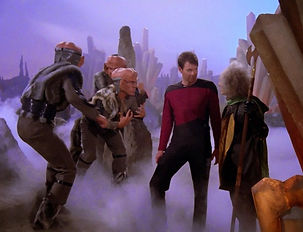
SKIPPABLE
The crew encounter the Ferengi on a dangerous ancient planet.
A typical TOS-inspired episode with the usual sage old alien with a lesson to either teach humanity to or learn from humanity. And while that narrative trope belongs in a museum, the same is false of this glacially slow, awkward episode. Not only that, but it also commits a capital sin: the introduction of the Ferengi, without which Star Trek as a whole would have been so much better. The only noteworthy aspect of this episode is the cool energy whips, which unfortunately will not be featured again in any later episodes (small price to pay, however, for not having to see a Ferengi fight again).
1.6 WHERE NO ONE HAS GONE BEFORE

Surely the best episode of Season 1. It is the only one where the quality of the dramatic presentation matches the ambition of the premise. It’s hard for a sci-fi show to tell a story about ultimate cosmic issues so early into its run, but this one succeeds. The Traveler is a riveting character who is excellently written and played with a much needed subtlety by Erik Menyuk; too bad that his return in later seasons wouldn’t be as convincing. This episode’s top strength is its deliberate vagueness: we don’t know how the Traveler does what he does, nor where the Enterprise ends up, nor how the situation is resolved. And while these may be drawbacks in other episodes, here they serve the story’s purpose well. Space-faring humanity is so backward that not only can it not comprehend all the answers, but doesn’t even know the right questions to ask. In a season full of half-assed episodes burdened by narrative awkwardness, bad acting, and shoddy characterization, this one shines like a lone diamond.
A new engine takes the ship to another galaxy.
SEASON TOP 5
1.7 LONELY AMONG US

SKIPPABLE
The ship is trapped in a nebula inhabited by energy life-forms.
Typical early-season filler with an uninspiring main plot garnished by a fairly useless side story. But perhaps its worst problem (aside from being totally unexciting) is that the resolution is downright unscientific and reeks of what could be called “magical thinking.” Future episodes would do a much better job at discussing the matter-energy duality, but here there is little science and even less consistency. How, exactly, does an energy being move or interact with matter? How does Picard retain his consciousness not only in the cosmic void, but inside the Enterprise computer? These are not mere technical problems, but serious plot holes.
1.8 JUSTICE
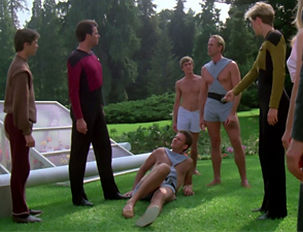
SKIPPABLE
Wesley is sentenced to death for a minor infraction on an idyllic planet.
The S1 installment that most closely resembles a TOS episode on its face: pretty planet with old customs that’s supposed to reveal a basic human truth through a stereotyped bait-and-switch. But the story falls flat in every way: it doesn’t exhaustively discuss faith, the death penalty, or even the Prime Directive, instead choosing cheap thrills and dubious plot twists. The eventual moral of the story -- “there can be no justice so long as laws are absolute” -- is valid, but it is so grossly under analyzed, coming in the last 30 seconds as it does, as to be useless. Three fun facts: (1) the Edo planet set will be reused for the Starfleet Academy HQ in S5’s “The First Duty”; (2) the design of “God” would be reused for the space station in S5’s “Conundrum”; (3) Josh Clark, Lt. Carey in VOY, appears as a young tactical officer here.
1.9 THE BATTLE
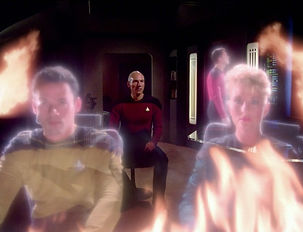
WATCH FOR CONTINUITY
Picard is forced to relive a battle from his old starship, the Stargazer.
An interesting exploration of a pivotal event from Picard’s past, with all the caveats of a Season One pseudo-drama. While the Ferengi are bad as usual, there is enough character-building lore to make this an important episode to watch. The Picard Maneuver and Data’s counteraction are also interesting and will receive more attention in future seasons. On the other hand, this is a huge missed opportunity to analyze what surely must be the second-most traumatic event in Picard’s life (after the stabbing). All the emotions that we see are simulated or induced by the Ferengi device, so we do not know how Picard truly feels about Maxia. That is too bad.
1.10 HIDE AND Q
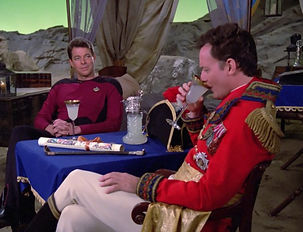
WORTH WATCHING
Q offers Riker infinite powers if he passes a certain test.
Aside from the common contrivances (like Q’s game and the laughable art direction: really, a lime green sky in a pose theater...?), this is the first truly compelling exploration of the ethics of the Continuum: what the Q need, where they are going and why, and how their powers relate to humanity’s future. The refusal of gifts at the end is well written and hints to the future tone of TNG as a whole. Despite Q being irredeemably obnoxious, the focus here is not really on him but on Riker, which helps the episode escape the abyss of Q-related nonsense.
1.11 HAVEN
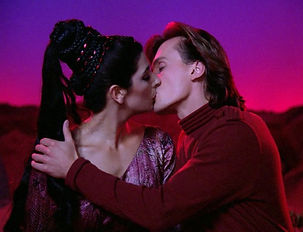
SKIPPABLE
Troi's mother arranges her daughter's marriage to a human man.
Entertaining in the same way that all Lwaxana episodes are: in equal measures irritating and funny. The mystery of Wyatt’s drawings and of the Tarellians is given criminally poor attention and solved through one brief conversation that reeks of deus ex machina. On the other hand, many of Lwaxana’s eventual mainstays (her search for a husband, her one-sided affair with Picard, Mr. Homn, etc.) are introduced to pretty good effect. The Riker-Troi backstory is also fairly decently developed, though surely not at the level of Peter David’s masterpiece novel Imzadi.
1.12 THE BIG GOODBYE

WATCH FOR CONTINUITY
The holodeck malfunctions during Picard's holonovel.
Both the primary and the secondary plots are forgettable, but this episode excels in laying the foundations for all future holodeck-based stories (even if some of the mechanics will be later refined). Consider this a required primer in the narrative possibilities of holodeck technology. The other face of the same coin is that most holodeck period pieces in Star Trek are contrived, stereotypical, and awkward. Sherlock Holmes from Season Two would be a welcome exception, but Dixon Hill is not. DS9 would do a much better job of exploring the mid-20th century setting with S6’s “Far Beyond the Stars.”
1.13 DATALORE

SEASON TOP 5
SEASON TOP 5
Data's long-lost brother, Lore, is discovered and reassembled.
This episode is notable for introducing Lore, the crystalline entity, and Data’s origin story, though future installments of this arc will be more effective. This is a basic “he may act good but he’s actually evil” trope, with criminally few discussions of the nature of cybernetic intelligence. Data’s emotive capacity (especially as relates to Lore’s) is also quite under analyzed and would have deserved a much more thorough treatment. That being said, Spiner does a great job in his dual role and the plot is enjoyable when it counts. It’s one of those S1 episodes that are required viewing in order to enjoy the rest of the show fully, but by itself it’s pretty average.
1.14 ANGEL ONE
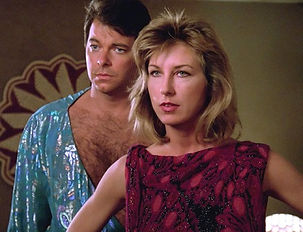
SKIPPABLE
Riker negotiates a deal on a planet ruled by a strict matriarchy.
While this is an interesting premise with some decent drama, it falls prey to a common problem of reverse narratives: its satire is too understated to be effective. Instead of using the reversal to criticize women’s condition in the real world, the episode is more successful in promoting the sexist subtext that “deep down women need men even if they say otherwise.” If you’re going to use a matriarchal society to show the flaws of a patriarchal one, make sure to spend more time on why humanity abandoned its patriarchy than on why Angel One needs to get rid of its matriarchy. So even though the analogy is fairly well constructed on its face, it takes a mind already attuned to its political values to truly entertain it; otherwise, it’s just plainly sexist.
1.15 11001001

SKIPPABLE
A team of cybernetically enhanced aliens steal the Enterprise.
TNG’s first true “action” episode and no doubt it’s a lot more exciting than the rest of the season thus far. Despite the obvious holes -- is it really so easy to steal a starship?! -- the plot is entertaining and stimulating. And for once, the secondary story is not filler but adds a thought-provoking twist on the holodeck technology that will receive more attention in later seasons and shows. The eventual resolution of the Bynars plot is so hasty that one wonders whether the authors realized what magnificent “plot bunny” they could work with: a planet whose inhabitants live in total symbiosis with computers. For all its technological prescience, it is astounding that Star Trek never explores this basic hard sci-fi idea more convincingly.
1.16 TOO SHORT A SEASON
A retired Startfleet admiral takes a rejuvenating drug to return to duty.
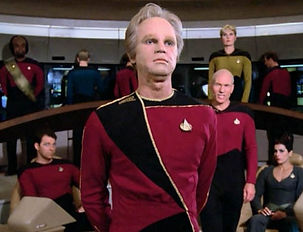
WORTH WATCHING
A solid personal drama built on sensitive writing and powerful performances is interspersed with a lackluster political thriller that has no bite. The failed negotiation from Jameson’s past isn’t nearly as well analyzed as it should be, and his character development suffers as a result. Still, the “quest for youth” subplot still succeeds in making us both care for and loathe him. An anticlimactic resolution leaves a bitter taste, but episode works for the most part. Excellent makeup visual effects, for the time: viewers have no way to realize Jameson’s real age until the big reveal.
1.17 WHEN THE BOUGH BREAKS

SERIES FLOP 20
A xenophobic and sterile species kidnaps human children.
Another episode with a good premise (a planet with a sterile population), a bad plot built around it (kidnapping kids), and a bad execution (predictable, slow, and riddled with plot holes). The Aldeans are 1960s storybook villains, completely unbelievable in their trite motives and banal dialogue. Alas, the crew does not fare better, and what could be an insightful discussion of the role of children in society becomes a series of cliched emotional jabs that by the halfway point has grown old. “Give us back the children!” “But you can make more!” Nope. S2’s “Up the Long Ladder” and S5’s “The Masterpiece Society” would do a slightly better job at tackling similar moral issues.
1.18 HOME SOIL
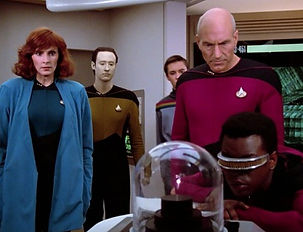
SEASON TOP 5
The crew discover a silicon-based life-form during a mining operation.
A classic hard sci-fi tale of discovery that fulfills the “new life” Trek moniker like few others. Some aspects are too simplistic, including a cavalier attitude to the life-form’s morality (too much, too soon, too easy). Still, the plot plays to its strengths, focusing on investigation and communication and ignoring all but the most basic drama. The notion of non-organic lifeforms, always a staple of speculative science fiction, is fairly well analyzed and steers clear of many of the usual scientific blunders. Future installments of a similar plot would also be good (e.g.: S3’s “Evolution” and especially S6’s “The Quality of Life”), but this episode did it first and did it very well.
1.19 COMING OF AGE
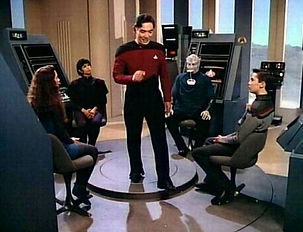
WATCH FOR CONTINUITY
Wesley attempts to take Starfleet Academy's entrance exam.
This episode is interesting not so much for its own merits but for the ground it lays for future narratives. Wesley’s Starfleet Academy entrance exam is a standard teen story with predictable twists and little to say; and Remmick’s investigation on the ship is such a blunt two-dimensional caricature that it’s hard to take it seriously. Yet the episode works, within reason, and both plot arcs are essential to future episodes (e.g.: S1’s “Conspiracy” and basically all Academy-related Wesley Crusher episodes yet to come).
1.20 HEART OF GLORY

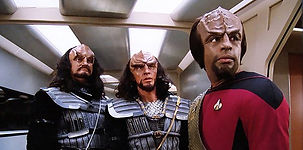
SEASON TOP 5
Two Klingon warriors attempt to take over the Enterprise.
One of the season’s best episodes, despite its abundant critics (including its own writer, amazingly). The Klingons’ much-anticipated first appearance in TNG is riveting and picks up where Star Trek VI: The Undiscovered Country would leave off three years later: a proud race hesitant to abandon its older ways and with a penchant for histrionics. It’s also a great opportunity to add a dramatic dimension to Worf, who comes into his own as one of the show’s most intriguing characters. Though the events are fairly predictable and a bit slow, the episode never strays from its goal of narrating the uneasy relations between the Federation and the Klingon Empire, of course through the lens of Worf’s origin story. Korris’s dialogue is written superbly and played well by eventual Star Trek veteran Vaughn Armstrong. Dorn is also decent, even though by this point he hasn’t developed as an actor yet. This is one of those episodes that is not only required to understand TNG’s and DS9’s politics, but is also genuinely good drama in its own right. Composer Ron Jones, who would score the masterpiece “The Best of Both Worlds” in S3-S4, writes a gorgeous dark version of Jerry Goldsmith’s classic Klingon theme, one that in my view is even better than Horner’s in ST3 and Eidelman’s in ST6.
1.21 THE ARSENAL OF FREEDOM
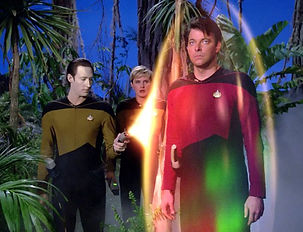
SERIES FLOP 20
The crew explore an ancient trade outpost that specialized in arms sales.
An episode with absolutely nothing to say and whose stereotypical let’s-try-to-escape-this-trap action isn’t even that entertaining. The basic premise is valid (galactic arms traders destroyed by their own stock), but there is so little discussion of it that the episode is effectively not about that anymore. Future Star Trek episodes would do a much better job at this, such as DS9’s “The Armageddon Game” and even VOY’s “Dreadnought,” in a way. The Picard-Crusher subplot is also a wasted opportunity for introspection and intimacy. Unfortunately, it would take TNG’s writers six years to get it right (S7’s “Attached”).
1.22 SYMBIOSIS
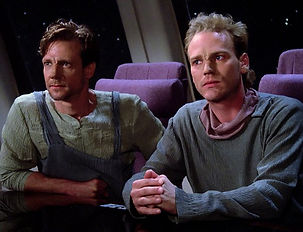
SKIPPABLE
A rich planet sells drugs to a poor one that's been addicted for centuries.
Star Trek’s only foray into the drug addiction topic is intriguing but ultimately disappointing. The plot advances too slowly to be enjoyable and wastes time on procedural events unrelated to the plot (e.g., the rescue). The eventual exposition-heavy revelation makes things better, but with a mixed record. On the one hand, the Tasha-Wesley conversation feels straight out of a cringe-worthy “just say no to drugs” educational video. On the other, the Picard-Crusher debate of the Prime Directive in the context of colonial exploitation contains outstanding and literate writing. In the end, what’s good about this episode is a bad case of too little too late. Fun fact: not one but two actors from Star Trek II: The Wrath of Khan guest star: Merritt Butrick (Kirk’s son David) as T’Jon, and Judson Scott (Khan’s top aide Joachim) as Sobi.
1.23 A SKIN OF EVIL
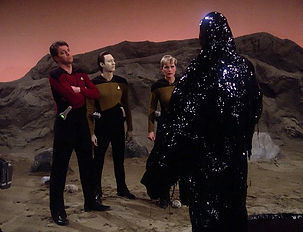
WATCH FOR CONTINUITY
A lonely and hostile alien on a remote planet kills Tasha Yar for sport.
[review here]
1.24 WE’LL ALWAYS HAVE PARIS
A experiment fragments spacetime throughout an entire sector.

SKIPPABLE
Star Trek rarely gets a time travel episode wrong, but some are less exciting than others. This one has a valid premise (an experiment gone awry) but a weak development and resolution, not to mention a dubious connection with Picard’s past. There’s never any real appreciation of what went wrong with the experiment, what the dangers are, and what “opening a door to another dimension” even means — which is too bad, since there was ample potential for something spooky or dangerous (cfr. with S2’s appropriately eerie “Time Squared” and with VOY’s amazing “The Omega Directive”). Plus, Picard‘s dealings with his ex flame are predatory and creepy, as is the fact that she lacks any agency and is but a token of discussion between two men. On the brighter side, the episode is visually appealing, especially in the Paris and the lab sections, but that’s not enough.
1.25 CONSPIRACY

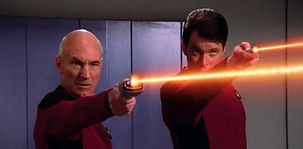
SEASON TOP 5
The Federation's top officials are being replaced by aliens.
This episode better than any other exemplifies everything that is right and wrong with the show’s first season. On the one hand, the action is excellent, the environments well rendered, and the premise bold and intriguing. On the other hand, many scenes are awkward and the acting often overly dramatic or downright shoddy. The idea of an attempted non-humanoid takeover of the Federation is excellent, and Star Trek would have to wait fifteen years to repeat this feat convincingly (the Dominion infiltration of Starfleet in DS9’s later seasons). The realization, instead, has highs and lows. Picard’s visit and Riker’s deception are thrilling, and the captains' summit at the start is creepy as all get-out. But the aliens themselves, as well as Rennick’s role, seem fresh out of a 1970s splatter horror movie. If that was the goal, kudos, but Star Trek writers aren’t known for popular culture references. Overall, the episode is entertaining and always worth a rewatch, but the only reason that it ranks among the season’s top 5 is that this season was just so weak that the bar was very, very low.
1.26 THE NEUTRAL ZONE

WATCH FOR CONTINUITY
The Romulan Empire contacts the Federation after 60 years of silence.
The season finale relies heavily on common Star Trek tropes: “backwards” 20th-century humans and slick aliens with ulterior motives. Fortunately, it is among the better installments of both story types, though their intermixing feels forced. The most important part is surely the return of the Romulans after a half-century of isolation and their establishment as the show’s main villains. They are cunning, creepy, and logical in all the right ways, and this episode foreshadows their eventual treatment in TNG: often credible and nuanced and rarely the cardboard caricatures of Soviets they were in TOS. This episode, like the one before it, also marks a distinct shift in storytelling, abandoning most overly dramatic quirks and focusing intensely on conflict and analysis. So while it is not as good as your average S3 episode, it is a much welcome change of pace and a good ending to S1.
